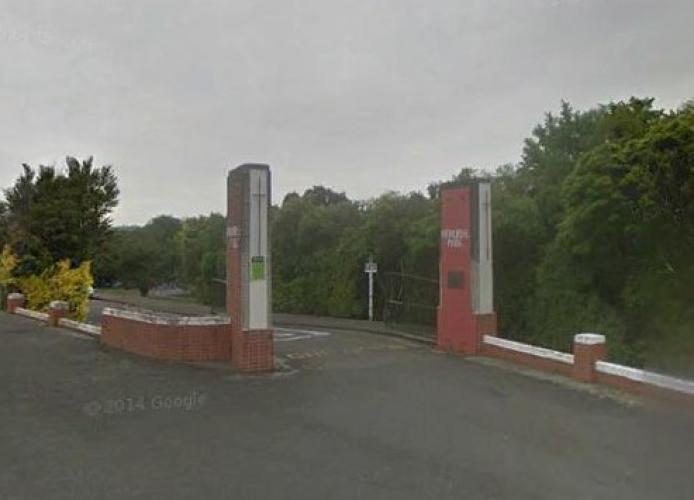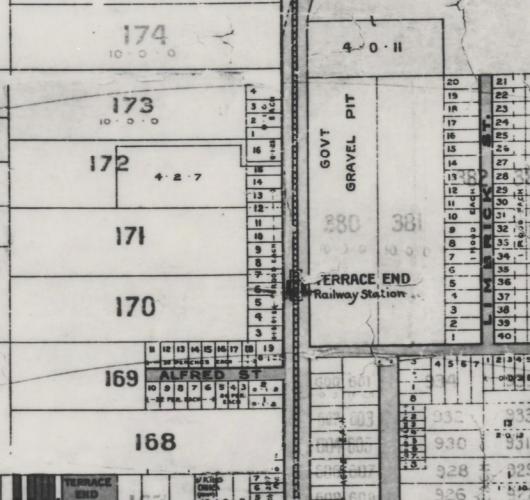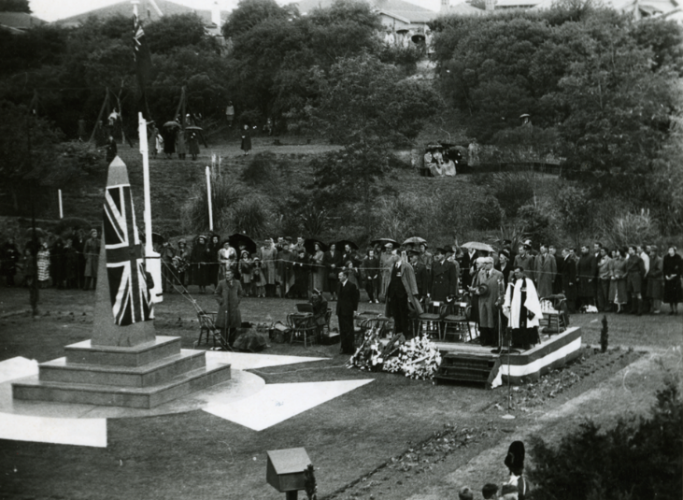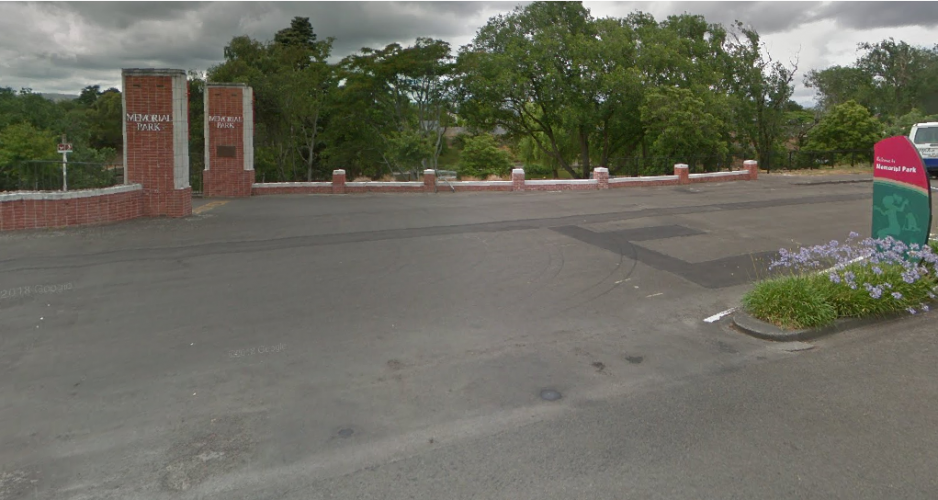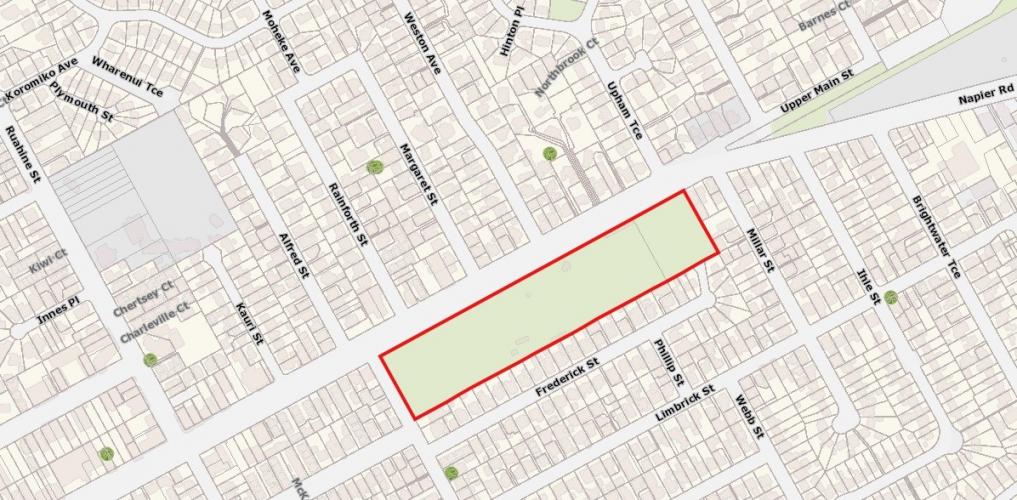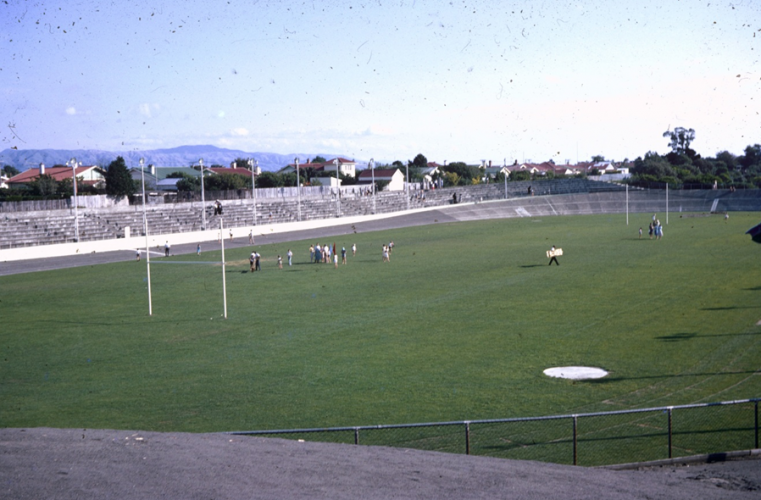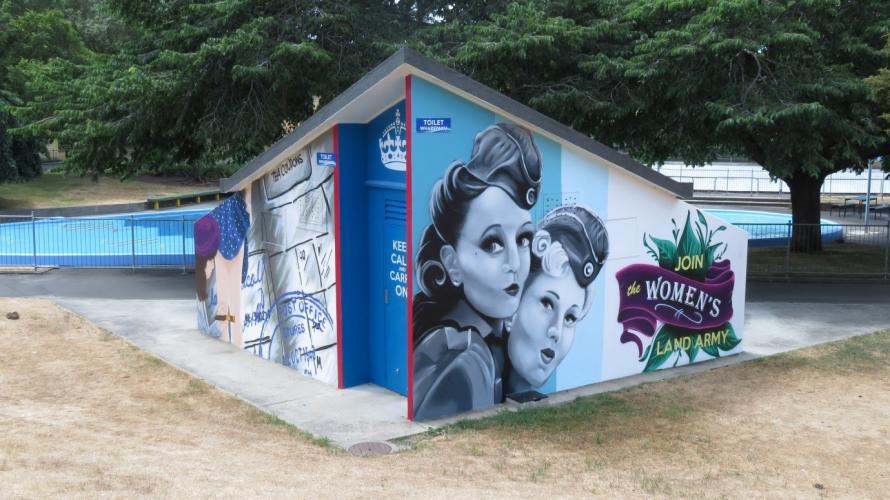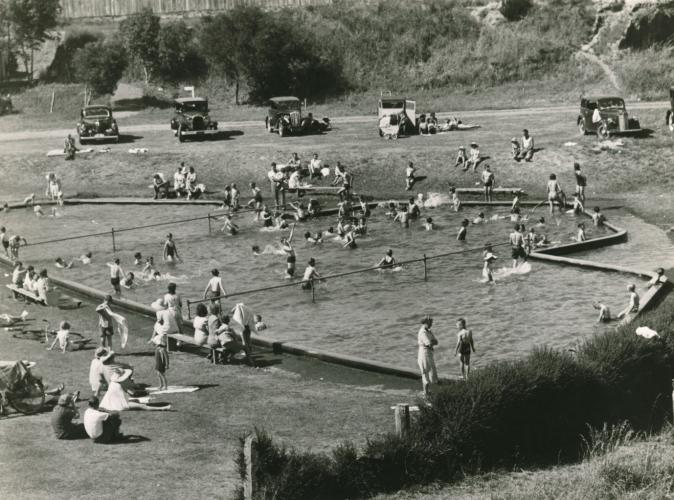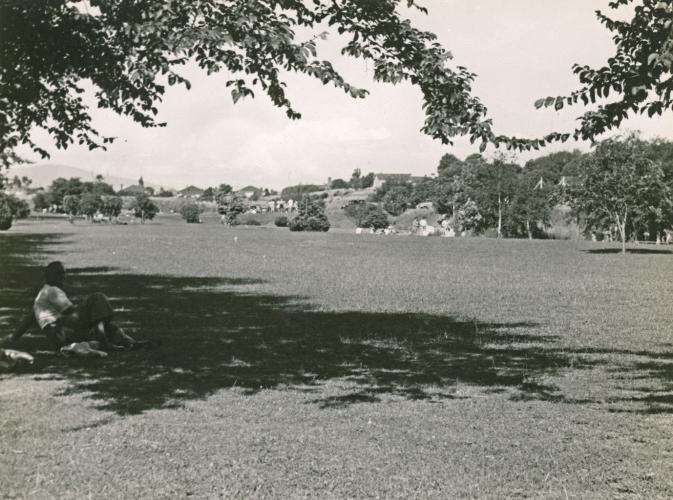126 Memorial Park Palmerston North, front gates to the park 2018
Reason for the name
This Terrace End park was named as a memorial to the servicemen and service women of World War 2.
Memorial Park is a popular park with playground facilities, shallow swimming pool, paddling pool and outdoor field used for national and local football competitions. Located in the suburb of Terrace End with the main entrance from Main Street/Napier Road, the park is the largest recreation area in the eastern end of Palmerston North. Other amenities in the area include The Palmerston North Golf Club, Ruamahanga Park, Manawatū River and Rangiora Reserve.
Author: Evan Greensides, Heritage Assistant for Palmerston North City Libraries & Community Services.
History of Memorial Park
Originally delineated as Section 380 within Palmerston North, the area making up Memorial Park was bounded to the north by the main Palmerston North-Foxton rail line from 1873. Primarily used as a timber transport hub to the Port of Foxton, the line commenced at this point and provided an ideal place to supply ballast when the line required conversion from wood to iron rails due to the weight of commodities being carted. The first 10 acres of the land was opened by the Government in 1876, with a further 4 acres, and a separate pit adjacent, opened in 1878 by the Manawatu County Council for road works. This smaller area was later purchased by the Railway Department, providing ballast for many of the large infrastructure projects around the region for the next six decades.
With the removal of the majority of the metal in the pit completed, the area lay semi-ideal before being leased for grazing to local residents, becoming increasingly covered in scrub. Concerned at a lack of fencing and the overgrown nature of the pit, the Borough Council negotiated a lease with the Railway Department in order to secure and beautify the western sections of the area in September 1922. This lease could not be acted on for another decade as the existing leaseholder rights had been protected.
In September 1936 the Minister of Railways offered Palmerston North City Council the right to purchase or lease the pit for the beautification purposes it had earlier negotiated. Since the pit was still being worked by the Railway Department, only the western half was offered. A year later, another offer to sell at 35 shillings per acre was offered to the Council, which was accepted, the sum total of £21.3.5 being finally settled in March 1939. Still named the Terrace End Pit, the Manawatu Standard recorded at the time:
The Palmerston North City Council undertook to find employment there for 25 men for a year, the contract being made with the Employment Board, and what was described in some quarters as an eyesore at one of the main entrances to the city has been transformed into a beauty spot already, with the promise of extensive changes yet to come.
Following this agreement, work on redeveloping the area commenced on 15 July 1937. Undergrowth was cleared and the site was levelled. In early 1938 the building of two swimming pools commenced, with both dedicated to those learning to swim. While the smaller, multi-depth tots pool proved popular, the larger adults pool was never completed due to complications over drainage. A sand pit was also built, and by March approximately 6 acres of groundwork and beautification had been completed and trees planted.
Opened on Arbor Day, 3 August 1938, the park was officially renamed Fitzroy Park, after the Second Governor of New Zealand, and a further amount of trees were planted by those who attended the ceremony. Beautification works officially finished in late 1940. The area was given minimal maintenance in order to let the land return to its natural state.
In November 1942 the Town Clerk inquired to the Palmerston North Station Master as to whether the Railway Department had given up its control of the portion of the park which it had been extracting metal. A reply from the District Engineer of the Department replied that they had let the rights lapse and that the intention was to uplift the tracks, reverting ownership back to PNCC. On 15 March 1943, New Zealand Railways posted in the New Zealand Gazette that the area had been reserved via warrant for recreation purposes. With WWII ongoing, the park was left in its natural state as resources were needed for the war effort. Although the now ex-Railway section became overgrown in this time, swimming pool use increased with the development of State Housing in the Ross Block. Being the only recreation area in the east end of Palmerston North at the time, the park proved to be a popular destination for families.
A referendum to Palmerston North citizens was raised in 1950 asking for a decision to be made on 2 different proposals for a WWII memorial. The first involved the building of 2 large bell towers as an extension of the Cenotaph in The Square, with the second being the creation of memorial gates and a recreation centre in the unused portion of Fitzroy Park. The final count on 23 November was 2,472 votes for the Bell Tower proposal, with Fitzroy Park receiving 3,696 votes.
The development of the unfinished area of Fitzroy Park envisaged memorial gates and a new road entrance from Main Street. A walking path starting at the gates would pass a sound shell bordering Fitzroy Street, with a lakelet in the south west corner of the park. The walking path would continue on between the lakelet and memorial shrine, leading on to the existing paddling pool which would border a new skating rink in the middle of the park. Dominating the east end would be a new open air arena, with a dedicated running and bicycle track, terraced seating, dressing rooms and public conveniences. Costing £40,000, with a government subsidy of £20,000, the task fell on multiple Council committees to raise the funds necessary for completion. Fundraising events included social evenings, a mock court, fireworks displays, concerts, race meetings, raffles, a golf tournament and extensive house-to-house canvassing by volunteers.
The first part of the park to be completed was the War Memorial, with the contract won by Hawke’s Bay Terrazzo. Although given a completion day of ANZAC Day 1952, the obelisk was not unveiled until 20 October, with Major-General Sir Howard Kippenberger speaking to a crowd of over 3000, and stating:
“Those who have died had given their lives before their time, that others might live on in freedom. It had been a just cause, each man accepted the hazard, hoping he would not be called on and it was fitting and right that in the city which was their focal centre, this should be remembered.”
The official dedication of Memorial Park took place on 3 December 1954 and included an RSA Guard of Honour commanded by Lieutenant-Colonel W D Philip, school cadets, and addresses by Mayor G Tremaine and Governor-General Lieutenant General Sir W Norrie.
Over the next 25 years the Memorial Park amenities became the centre of many activities with varied usage, including the New Zealand Summer Games, National Athletic and Cycling Championships, and as a venue for hockey, soccer and rugby league of all grades. After playing the Manawatu cricket team in April 1958, the Pakistani team noted that they were “favourably impressed with the facilities at Memorial Park and were loud in their praise of the lights and ground itself.” The original children’s pool was replaced in 1986 after nearly 50 years of service, and part of the spectator bank in the arena was roofed over the year after. After the cycle track deteriorated and better amenities were found elsewhere, a speed skating track was constructed around the outside of the field in 2002, with the original sloping concrete left in place.
Palmerston North City Council adopted the Memorial Park Development Plan in June 2017. The plan describes the values that the Park commemorates, how those values are to be revived over the next ten years and what the park will ultimately look like going forward. The values of service to nation, personal sacrifice and freedom are embodied in this plan and the work that will be carried out in the park.
The NZ Army will be reintroducing a 20-pound artillery piece and redeveloping a new entranceway. This entranceway will feature murals of local heroes, wrapping the centre-piece which will be the original monument flag-pole newly restored. A new splash pad surfacing will be designed with a bright blue background with red poppies woven into the play feature. The toilet blocks have murals with the theme of “women at war” to link with the plaque in the Park dedicated women that served from 1939-1945.


